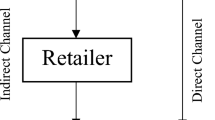Abstract
This paper analyzes a stochastic inventory problem with an order-time constraint that restricts the times at which a manufacturer places new orders to a supplier. This constraint stems from the limited upstream capacity in a supply chain, such as production capacity at a supplier or transportation capacity between a supplier and a manufacturer. Consideration of limited upstream capacity extends the classical inventory literature that unrealistically assumes infinite supplier/transporter capacity. But this consideration increases the complexity of the problem. We study the constraint under a Poisson demand process and allow for a fixed ordering cost. In presence of the constraint, we establish the optimality of an (s,S) policy under both the discounted and average cost objectives. Under the average cost objective, we show the uniqueness of the order-up-to level S. We numerically compare our model with the classical unconstrained model. We report significant savings in costs that can be achieved by using our model when the order time is constrained.
Similar content being viewed by others
References
Archibald, B. C. (1981). Continuous review (s,S) policies with lost demand. Management Science, 27(10), 1171–1177.
Archibald, B. C., & Silver, E. (1978). (s,S) Policies under continuous review and discrete compound Poisson demand. Management Science, 24(9), 899–909.
Bensoussan, A., & Lions, J.-L. (1984). Impulse control and quasi-variational inequalities. Paris: Gauthier-Villars.
Bensoussan, A., Liu, R. H., & Sethi, S. P. (2005). Optimality of an (s,S) policy with compound Poisson and diffusion demands: a quasi-variational inequalities approach. SIAM Journal on Control and Optimization, 44(5), 1650–1676.
Beyer, D., & Sethi, S. P. (1997). Average cost optimality in inventory models with Markovian demands. Journal of Optimization Theory and Applications, 92(3), 497–526.
Beyer, D., Cheng, F., Sethi, S. P., & Taksar, M. I. (2010). Markovian demand inventory models. New York: Springer.
Bradley, J., & Arntzen, B. (1999). The simultaneous planning of production, capacity, and inventory in seasonal demand environments. Operations Research, 47(6), 795–806.
Duran, A., Gutierrez, G., & Zequeira, R. I. (2004). A continuous review inventory model with order expediting. International Journal of Production Economics, 87, 157–169.
Ehrhardt, R. (1984). (s.S) policies for a dynamic inventory model with stochastic leadtimes. Operations Research, 32(1), 121–132.
Federgruen, A., & Schechner, Z. (1983). Cost formulas for continuous review inventory models with fixed delivery lags. Operations Research, 31(5), 957–965.
Federgruen, A., & Zipkin, P. (1986). An inventory model with limited production capacity and uncertain demands, the average cost criterion. Mathematics of Operations Research, 11(2), 193–207.
Hadley, G., & Whitin, T. M. (1963). Analysis of inventory systems. Englewood Cliffs: Prentice-Hall.
Harrison, J. M. (1978). The diffusion approximation for tandem queues in heavy traffic. Advances in Applied Probability, 10, 886–905.
Iglehart, D. L., & Whitt, W. (1970). Multiple channels queues in heavy traffic. Advances in Applied Probability, 17(2), 150–177.
Kaplan, R. S. (1970). A dynamic inventory model with stochastic lead times. Management Science, 16(7), 491–507.
Moinzadeh, K., & Nahmias, S. (1988). A continuous review model for an inventory system with two supply modes. Management Science, 34(6), 761–773.
Nahmias, S. (1979). Simple approximations for a variety of dynamic leadtime lost-sales inventory models. Operations Research, 27(5), 904–924.
Porteus, E. L. (2002). Foundation of stochastic inventory theory. Stanford: Stanford University Press.
Presman, E., & Sethi, S. P. (2006). Inventory models with continuous and Poisson demands and discounted average costs. Production and Operations Management, 15, 279–293.
Şahin, İ. (1979). On the stationary analysis of continuous review (s,S) inventory systems with constant lead times. Operations Research, 27(4), 717–729.
Şahin, İ. (1982). On the objective function behavior in (s,S) inventory models. Operations Research, 30(4), 709–723.
Şahin, İ. (1990). Regenerative inventory systems: operating characteristics and optimization. New York: Springer.
Sethi, S. P., & Cheng, F. (1997). Optimality of (s,S) policies in inventory models with Markovian demand. Operations Research, 45(6), 931–939.
Sobel, M. J., & Zhang, R. Q. (2001). Inventory policies for systems with stochastic and deterministic demand. Operations Research, 49(1), 157–162.
Song, J. S., & Zipkin, P. H. (1993). Inventory control in a fluctuating demand environment. Operations Research, 41(2), 351–369.
Stidham, S. (2002). Analysis, design, and control of queuing systems. Operations Research, 50(1), 197–216.
Veinott, A. F., & Wagner, H. M. (1965). Computing optimal (s,S) inventory policies. Management Science, 11, 525–552.
Zhao, Y., & Katehakis, M. N. (2006). On the structure of optimal ordering policy for stochastic inventory systems with minimum order quantity. Probability in the Engineering and Informational Sciences, 20, 257–270.
Zheng, Y. S. (1992). On properties of stochastic inventory systems. Management Science, 38(1), 87–103.
Zhou, B., Katehakis, M. N., & Zhao, Y. (2009). Managing stochastic inventory systems with free shipping option. European Journal of Operational Research, 196(1), 186–197.
Zipkin, P. H. (1986). Stochastic leadtimes in continuous-time inventory models. Naval Research Logistics Quarterly, 33, 163–774.
Zipkin, P. H. (2000). Foundations of inventory management. New York: McGraw-Hill.
Author information
Authors and Affiliations
Corresponding author
Additional information
A. Bensoussan also affiliated with Department of Logistics and Maritime Studies, Hong Kong Polytechnic University.
Rights and permissions
About this article
Cite this article
Bensoussan, A., Moussawi-Haidar, L. & Çakanyıldırım, M. Inventory control with an order-time constraint: optimality, uniqueness and significance. Ann Oper Res 181, 603–640 (2010). https://doi.org/10.1007/s10479-010-0791-1
Published:
Issue Date:
DOI: https://doi.org/10.1007/s10479-010-0791-1




